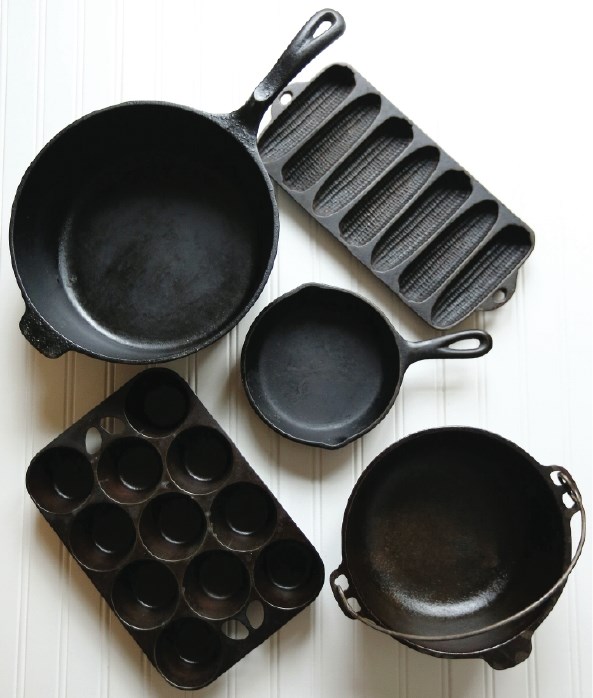 Walk into the kitchen of a Victoria home a century ago and you wouldn’t find Teflon skillets and silicone muffin pans.
Walk into the kitchen of a Victoria home a century ago and you wouldn’t find Teflon skillets and silicone muffin pans.
They weren’t invented yet.
But what I call the original non-stick cookware — cast-iron pans — were in daily use and some from that era could still be in kitchens today.
I say that because cast-iron pans such as skillets, Dutch ovens, griddles and other vessels are built to last — if you treat them right.
The Chinese made the material for cast iron vessels as early as the Han Dynasty. In those early days, they used them for salt evaporation. That material later became moulded into cast- iron cooking pots and they eventually found their way to places such as Europe and the New World.
For centuries before electric ovens, cooks were fond of cast-iron pans because they could retain and evenly distribute heat.
The pans were also popular because they could be used in hot and rugged cooking conditions, such as in a hearth, hung over a campfire or even nestled in the coals of a fire.
When pans with non-stick surfaces came into use in the 1960s, cast-iron pans fell out favour. One big reason was that they were prone to rusting if not cared for properly. But taking care of them is not difficult and if you do they’ll last for decades.
Cast-iron cookware is made by pouring molten iron into moulds. During the process, microscopic air bubbles rise, causing tiny holes to form on the surface when the iron sets. If the pan is not properly seasoned (sealed) before it’s used, moisture getting into those holes can eventually cause the pan to rust.
Some companies conveniently sell their pans already seasoned and ready to use. Other companies require you to do the seasoning and recommended techniques vary.
When I season a new cast-iron pan, I wash and thoroughly dry it first. I lightly wipe the pan, handle included, with a thin coating of vegetable oil. Don’t apply too much oil or you may get a sticky finish.
The pan goes into a 350° F oven for one hour, the oven gets turned off, I let the pan cool there to room temperature and then take it out. I then apply another thin coating of oil and it’s ready to use. During the heating process, you could put a baking sheet on a rack below the pan to catch any dripping oil.
After each use, I wash the pan in hot, soapy water. I never let it soak too long and avoid using abrasive cleansers or scrubbers that may “un-season” the pan. I then dry the pan well and after the first few uses, will wipe it with another thin coat of oil before storing until needed again.
If you own an old cast-iron pan and it’s rusted, you should be able to revive it by first moistening the pan with water and sprinkling it with scouring powder. Now scrub away the rust with a metal scrubbing pad. In this case, you can use abrasive cleaning products, as you will be seasoning the pan again. I’ll then wash, dry and then oil, heat and season the pan as I described above.
When seasoned and handled properly, the pan darkens and forms a coating that prevents sticking and rust from forming.
I’ve discovered that if I frequently use the pan and wash and dry it properly, I no longer have to keep oiling it before storing it away.
I know that to be very true because my wife and I own a nice collection of new and old cast-iron pans that we, as folks in Victoria would have 100 years ago, frequently use to cook just about everything, from pancakes to steaks and roast chicken.
Skillet Roast Chicken with Lemon, Garlic and Sage

Skillet Roast Chicken with Lemon, Garlic and Sage. [Adrian Lam, Times Colonist]
Juicy, aromatic roast chicken flavoured inside and out with lemon, garlic and sage.
Preparation time: 20 minutes
Cooking time: About 90 minutes
Makes: 4 servings
- 1 medium lemon
- 2 Tbsp olive oil
- 1/2 tsp paprika
- 1 (3 lb.) chicken, patted dry
- 6 large garlic cloves, thinly sliced
- 16 fresh sage leaves
- 1/2 small onion, sliced
- salt and freshly ground pepper to taste
Preheat the oven to 350 F. Finely zest the lemon; place the zest in a small bowl. Cut the lemon in half and squeeze its juice into the bowl. Mix in the oil and paprika. Cut the squeezed lemon halves into chunks.
With your fingers, working from the cavity end, carefully loosen and lift up the skin off the top of each breast. Slide half of the garlic slices and eight of the sage leaves underneath the skin, pushing them into different spots around the chicken. Press and set the skin back into place.
Stuff the onion, lemon chunks and the remaining garlic and sage into the cavity of the chicken. Fold and tuck the chicken’s wings under its body and tie the legs together. Set the chicken in a 10-inch cast- iron skillet. Brush the lemon juice/zest mixture all over the chicken. Season with salt and pepper.
Roast the chicken, brushing it occasionally with the pan juices, for 90 minutes, or until an instant-read thermometer inserted into the deepest part of the thigh registers 170 F. Transfer the chicken to a plate, tent with aluminum foil and rest 10 minutes before carving and serving.
Eric’s options: If you would like gravy, remove the fat from pan drippings. Add 2 cups of chicken stock and bring to boil. In a bowl, mix 3 Tbsp all-purpose flour with 1Ú2 cup chicken stock until smooth. Slowly whisk into the boiling stock and simmer until the gravy thickens.
Fig and Almond Clafouti

Clafouti is a French-style dessert of fruit baked in a custard-like batter. [Adrian Lam, Times Colonist]
Clafouti is a French-style dessert of fruit baked in a custard-like batter. The fruit in this version is small and flavourful dried, black mission figs, which are soaked and softened before being used.
Preparation time: 20 minutes, plus soaking time
Cooking time: 25 minutes
Makes: 8 servings
- 24 dried black mission figs (see note)
- 4 cups boiling water
- 2 Tbsp butter, at room temperature
- 6 large eggs
- 2/3 cup milk
- 1/3 cup granulated sugar
- 2 tsp grated orange zest
- 1/3 cup orange juice
- 2 tsp pure vanilla extract
- 1/2 tsp ground cinnamon
- 1/4 tsp ground nutmeg
- 3/4 cup all-purpose flour
- 1/4 cup sliced skin-on almonds
- Icing sugar to taste, for dusting
- Whipped cream or crème fraîche, to taste (optional)
Place the figs in heatproof bowl and pour in the boiling water. Let figs plump in the water 30 minutes. Drain the figs well and then set aside.
Preheat the oven to 425° F. Brush the inside of a 10-inch cast-iron skillet with the butter.
Place eggs in a medium bowl and beat until thoroughly blended. Mix in the milk, sugar, zest and juice, vanilla, cinnamon and nutmeg. Sprinkle in flour and whisk until a smooth batter is created.
Pour the batter into the skillet. Set the figs on top off the batter and then sprinkle with the almonds. Bake the clafouti in the middle of the oven for 25 minutes or until puffed on the sides, golden on top and the filling is set.
Cool the clafouti 20 minutes and then serve warm. Or, cool to room temperature and serve that way. Lightly dust the clafouti with icing sugar just before cutting into wedges and serving. If desired, top each plated wedge of clafouti with a dollop of whipped cream or crème fraîche.
Note: Dried black mission figs, which are about 11Ú2 inches long, are sold in the bagged, dried fruit aisle of most supermarkets. You will also find them at stores offering a good selection of bulk foods. Tangy, sour cream-like crème fraîche is sold in tubs at some supermarkets.
Eric Akis is the author of Everyone Can Cook Everything. His columns appear in the Life section of the Times Colonist on Wednesday and Sunday..
